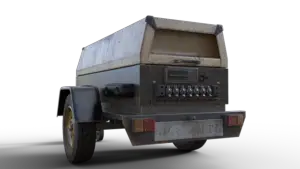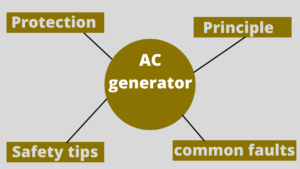Electric generators have batteries! This may be insane for non-professional workers. However, I have found some important questions about generator batteries, I will answer these questions to help you. Let’s get started.
Table of Contents
Why does an electrical generator need a battery?
In many generator sets, especially those designed for emergency or standby power, batteries are indeed an integral component.
The primary purpose of these batteries is to provide electrical energy to start the generator’s internal combustion engine.
Here’s how it typically works:
- Starting the Engine: The generator set includes an internal combustion engine that needs to start quickly when a power interruption occurs. The battery is responsible for supplying the initial burst of electrical energy required to turn over the engine.
- Ignition and Fuel System: Once the engine is turning, the generator’s ignition system and fuel system take over, and the engine begins running on its own.
- Generating Power: As the engine runs, the generator component (alternator) starts producing electrical power. At this point, the generator may continue to draw a small amount of power from the battery to support its internal systems.
- Charging the Battery: Many generator sets also have a built-in battery charger. As the generator produces electricity, it can use a portion of that power to recharge the battery. This ensures that the battery remains charged and ready for the next start cycle.
This setup is common in backup power systems for critical applications such as hospitals, data centers, or emergency services, where an uninterrupted power supply is essential.
The use of batteries ensures that the generator can start quickly and reliably in the event of a power outage, providing seamless backup power to the connected systems.
How Does a Generator Charge its Battery?
The generator charges its battery Using the power of its engine. The charging system, which charges generator batteries, is a simple Dynamo (DC generator, like the one in your car), it’s directly connected to the batteries.
It charges the batteries when the generator is working. If the generator is stand-by, or out of service, we use a separate charging power supply to keep the batteries charged.
Let’s break this down;
- Charging System: The charging system for generator batteries is typically a simple dynamo, which is a type of DC generator. This dynamo is directly connected to the batteries.
- Charging During Operation: When the generator is actively working and producing electricity, the dynamo charges the batteries. This ensures that the batteries remain charged and ready to supply power when needed.
- Standby Charging: In situations where the generator is on standby and not in active service, a separate charging power supply is used to maintain the charge of the batteries. This practice is essential to ensure that the generator can start promptly in the event of a power interruption.
This configuration is common in standby generator systems, where reliability and quick start-up are crucial.
The separate charging power supply for standby mode ensures that the batteries are always in good condition and capable of providing the necessary starting energy when the generator is called into action.
Why is my generator not charging the battery?
If your generator is not charging the battery, there could be several reasons for this issue. Here are some common factors to consider:
- Faulty Charging System: The charging system of the generator may be malfunctioning. This could be due to a defective alternator, voltage regulator, or other components in the charging circuit.
- Loose or Damaged Wiring: Check for loose or damaged wires in the charging circuit. A poor connection can hinder the flow of electricity from the generator to the battery, preventing proper charging.
- Faulty Battery: If the battery itself is faulty, it may not accept a charge even if the charging system is working correctly. Test the battery’s voltage and condition to ensure it is in good working order.
- Blown Fuse or Circuit Breaker: Some generators have fuses or circuit breakers in the charging circuit. Check for blown fuses or tripped circuit breakers that may be interrupting the charging process.
- Failed Voltage Regulator: The voltage regulator controls the output voltage of the generator’s alternator. If the voltage regulator is faulty, it may not allow the proper charging voltage to reach the battery.
- Belt Tension: If your generator uses a belt-driven alternator, check the tension of the belt. A loose or slipping belt can affect the performance of the alternator and, consequently, the charging system.
- Generator RPM: Generators often need to run at a certain RPM (revolutions per minute) to generate the correct voltage for charging. If the generator is not running at the required RPM, it may not be producing enough voltage to charge the battery.
- Dirty or Faulty Connections: Dirty or corroded electrical connections can impede the flow of electricity. Ensure that all connections in the charging circuit are clean and free from corrosion.
If you’re not familiar with the internal components of your generator or if troubleshooting doesn’t resolve the issue, it’s recommended to consult the generator’s manual or seek assistance from a qualified technician.
Professional help may be needed to diagnose and repair more complex issues with the charging system.
Can you jump-start a generator battery?
Yes, you can jump-start a generator battery like jump-starting a car battery. The process involves using jumper cables to connect the generator battery to another power source, such as a charged battery from a vehicle or another generator. Here’s a step-by-step guide:
Materials Needed:
- Jumper cables
- Another generator, a vehicle with a charged battery, or a portable jump starter
Procedure:
- Ensure Safety: Turn off the generator and any connected loads before attempting to jump-start the battery. Make sure the generator is in a safe location and follow proper safety precautions.
- Identify Terminals: Locate the positive (+) and negative (-) terminals on both the dead generator battery and the charged battery or power source.
- Connect Positive (+) Cable:
- Connect one end of the positive (+) jumper cable to the positive (+) terminal of the charged battery or power source.
- Connect the other end of the positive (+) jumper cable to the positive (+) terminal of the dead generator battery.
- Connect Negative (-) Cable:
- Connect one end of the negative (-) jumper cable to the negative (-) terminal of the charged battery or power source.
- Connect the other end of the negative (-) jumper cable to a metal surface on the generator frame, away from the dead battery. This provides a good ground connection.
- Start the Generator: If using another generator or a vehicle, start the engine. Allow it to run for a few minutes to provide a charge to the dead generator battery.
- Attempt to Start the Generator: After letting the charged battery or power source provide some charge, attempt to start the generator. If the generator starts, let it run for a while to allow the alternator to further charge the battery.
- Disconnect Cables: Once the generator is running and the battery is charging, carefully disconnect the jumper cables in the reverse order of connection.
- Monitor Battery: Keep an eye on the generator battery to ensure it continues to hold a charge. If the battery is old or damaged, you may need to consider replacing it.
It’s important to note that while jump-starting a generator can be a temporary solution, addressing the underlying issue with the charging system or the generator battery is crucial for a long-term fix.
If the generator battery repeatedly fails to hold a charge, it may need to be replaced, and if the charging system is faulty, it should be repaired or replaced by a qualified technician.
Don’t Leave Empty-Handed!
Install my Free Android App on Google Play:
Electrical Cables Most Common Tables “Cables Tables”
And, my Electrical Calculations App “Fast Electrical Calculator”
Discover more great content by subscribing to My channel
Looking to stay ahead of the game in the world of electrical engineering? Subscribe to my YouTube channel and gain access to exclusive content you won’t find anywhere else!
The staff I recommend
(Amazon Affiliate Links to products I believe are high quality):
- Economy 120 Volt/60Hz AC Power Source – Step-Down Voltage & Frequency Converters 1800W
- UNI-T Digital Multimeter Tester UT139C
- 50-Amp Extension Cord for RV “100ft”
- Voltage Stabilizer 110/220v
- Hair Dryer “best selling“
- TOSHIBA EM131A5C-BS Countertop Microwave Ovens
Disclaimer: This contains affiliate links to Amazon products. I may earn a commission for purchases made through these links.


